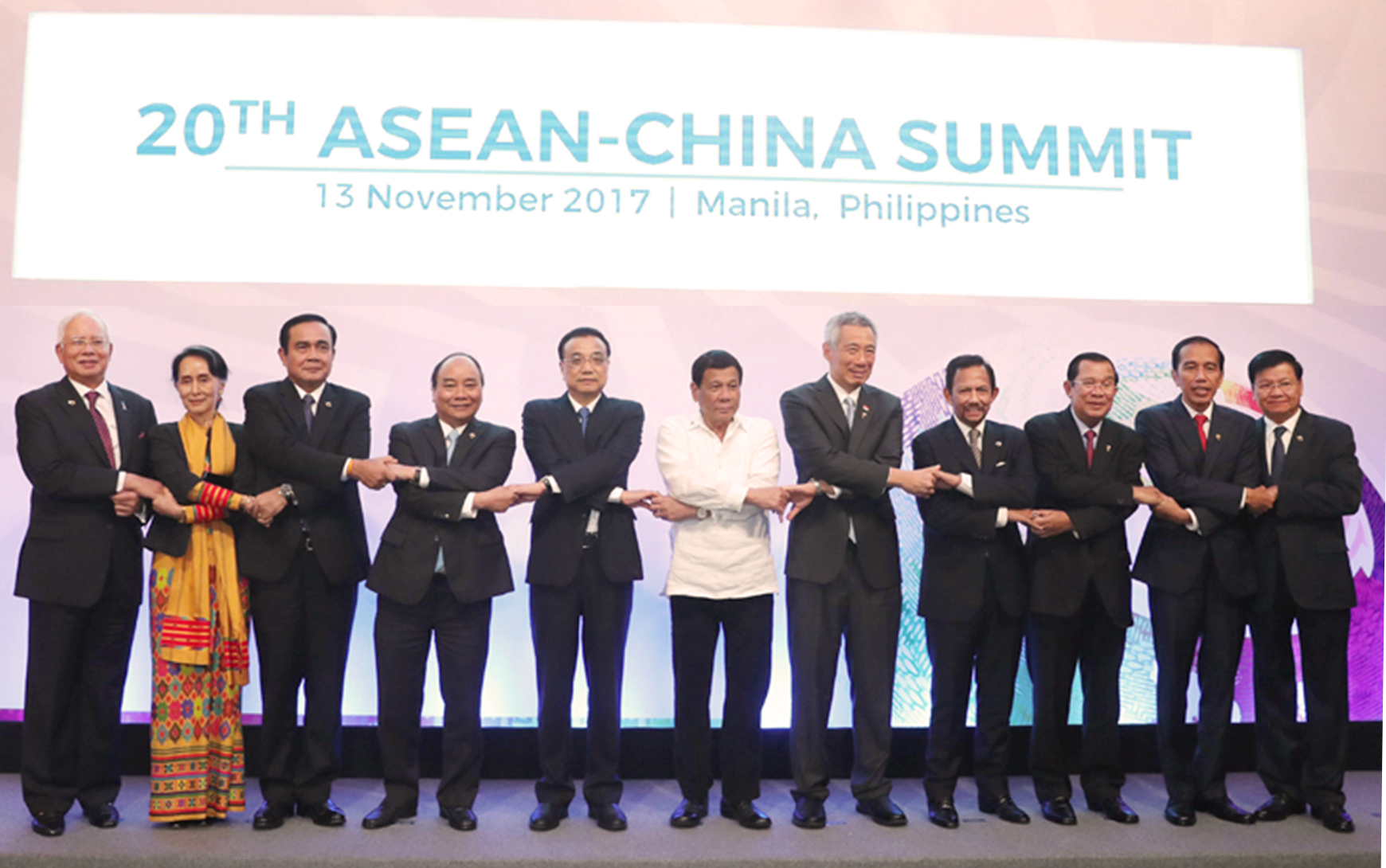Experts laud ASEAN model, ties with China

Chinese Premier Li Keqiang (5th L) takes group photos with the leaders of the 10 ASEAN countries prior to the 20th ASEAN-China Summit that was held on Nov. 13 in Manila, the Philippines.
Scholars praised the development model of the Association of Southeast Asian Nations (ASEAN) and its relations with China after the leaders’ meetings on East Asia cooperation were recently concluded in Manila, the Philippines.
2017 marks the 50th founding anniversary of ASEAN and the 20th anniversary of the launch of the “ASEAN Plus Three (China, Japan and South Korea)” cooperative model. When it was established, ASEAN faced the challenge of bringing peace and prosperity to a poor, turbulent region, but after 50 years, Southeast Asia has become an oasis for global peace and stability. It is now one of the most energetic and promising areas in the world.
Experts attribute the rapid development of the region to the distinctive ASEAN model, which respects differences and values progressiveness unlike the EU model that stresses rigid rules and treaties.
Mutual respect, consensus, non-interference into others’ internal affairs, concentrated institutional arrangements, and open, pragmatic regionalism are among the rich connotations of the ASEAN model, said Wei Ling, director of the Research Center for Chinese Diplomatic Theory at China Foreign Affairs University.
As regional cooperation expands and advances, the ASEAN model has gradually become an example for cooperation in East Asia, even the Asia-Pacific region, Wei said.
Zhang Yunling, CASS Member and a research fellow on international studies at the Chinese Academy of Social Sciences (CASS), noted that previous regional theories and practices were mostly grounded in cooperation in Europe, but the crises in the European Union suggest that the EU model is not perfect.
The development of ASEAN has been relatively smooth perhaps because the flexibility of the model has ensured its internal vitality, Zhang said, adding that the experience offered by the ASEAN model is of extraordinary significance because the world and various regions are undergoing major transformations and plagued by interwoven contradictions.
Of the partnerships with ASEAN, the relationship with China is recognized as the most vigorous and profound. Since 1991, when China and ASEAN established dialogue relations, the two sides have withstood tests arising from shifting regional and global landscapes, deepening mutual political trust and increasing the fruits of pragmatic cooperation.
China was the first foreign country to join the Treaty of Amity and Cooperation in Southeast Asia, ASEAN’s first strategic partner and the first to start free trade zone (FTZ) negotiations with the bloc.
As to economic and trade cooperation, China has been ASEAN’s biggest trade partner for eight consecutive years, and ASEAN has been China’s third-largest trade partner for six years in a row. umulative two-way direct investment has nearly reached $200 billion. The upgraded China-ASEAN FTZ and the Lancang-Mekong cooperative mechanism have effectively boosted regional economic cooperation.
People-to-people exchanges are also thriving, constituting the third pillar of bilateral ties together with political security and economic cooperation. In 2016, more than 31.8 million mutual visits were paid. China has become the largest source of overseas tourists for ASEAN.
Zhang said the stable China-ASEAN relationship is contributed by bilateral efforts to align the Chinese and ASEAN models.
2018 will mark the 15th anniversary of the China-ASEAN strategic partnership, when a new journey of upgraded bilateral relations will begin and East Asian cooperation will embrace new opportunities. Scholars said that the “Belt and Road” initiative will be the key to upgrading the relationship.
“When it comes to trade and investment between China and countries along the Belt and Road in 2016, ASEAN countries took the first four spots of China’s five biggest trade partners, and six ASEAN nations were among China’s top 10 investment destinations,” said Wang Qin, head of the Center for Southeast Asian Studies at Xiamen University.
ASEAN is a crucial region for infrastructure interconnectivity within the “B&R” initiative, an important zone for promoting international production capacity and equipment manufacturing cooperation, the first choice for FTZ upgrading, a gathering place for Chinese enterprises to “go out,” and a demonstration area for facilitating people-to-people exchanges, Wang said.
Regarding how to drive East Asian cooperation to a new stage, the Regional Comprehensive Economic Partnership (RCEP) is regarded critical to propeling economic integration in the region. At the RCEP leaders’ meeting held in Manila on Nov. 14, all parties concerned expressed the strong wish for deeper East Asian economic cooperation.
Statistics show that the RCEP, if established, will bring into being a trade bloc with a population of approximately 6 billion, GDP of about $21 trillion, and roughly 30 percent of the world trade volume.
“Different from previous multiple ‘10 Plus One’ FTZ frameworks, the RCEP is to incorporate ASEAN and six dialogue partners into an FTZ framework, which will lay a groundwork for building a greater economic community,” Zhang said.
MAO LI is a reporter at the Chinese Social Sciences Today
